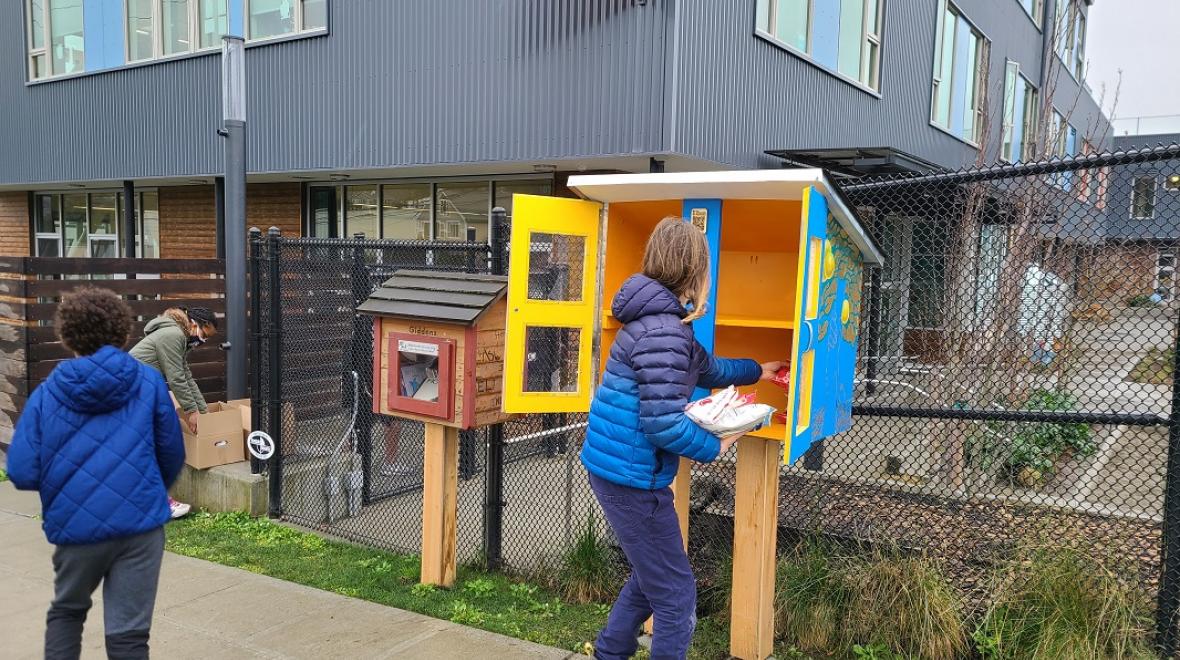
Photo:
Students stock the Free Little Pantry on the school grounds. Photo courtesy Giddens School
We all care about the neighborhood we live in and the well-being of our neighbors. We care about people who are experiencing homelessness, too. But welcoming the homeless as our neighbors requires navigating a path where our values run up against our fears and (often incorrect) assumptions. When one local private school moved next door to a homeless encampment, that was exactly what they challenged themselves to do.
The independent preschool–grade 5 Giddens School focuses on justice in its curriculum and has a long tradition of service learning. When the school moved into its new campus in the Rainier Valley in December 2019, there was already a small homeless encampment north of the school.
As the pandemic progressed, the number of people camped out on the other side of the empty lot swelled, and with the population, so did the problems. Chief among them was that when fights broke out on the street, safety protocols required the school to go into lockdown. Head of School Morva McDonald decided it was time for Giddens School to have a talk with the neighbors.
Meet the neighbors
The first step was a call to Seattle’s Navigation Team (which has been since been replaced by the HOPE Team) to request an introduction.
In August, McDonald and members of the Navigation Team brought lunch to the encampment and had a real conversation with some of the men who were living there. McDonald explained how fights at the camp disrupted the school day, and learned about the living conditions at the camp.
“One of the things that became clear to me was that there were some basic needs that weren’t being met,” says McDonald. First among these was access to water, so the Giddens school community began making weekly water deliveries. Since then, McDonald has made a point of walking over to the encampment regularly to check in with the residents. In the process, these neighbors, especially Anthony, Kenneth and Trapper, have become key players in a mutually beneficial partnership with the new arrival to the neighborhood, the Giddens School.
Reciprocal relationships
Down from a summertime peak of nearly a dozen, there are between four and six consistent residents in the camp near the school. McDonald notes that they are predominantly elderly Black men who have lived in Seattle for decades. “I think that’s a travesty. I think it tells us something about the way that we have treated African-American men historically, and it lands with real individuals. For me, the challenge is how do we look at that and actually try to do right by somebody?” says McDonald. But she is clear that there is no place for savior narratives in this situation.
“Some of these people have lived in this neighborhood certainly longer than our school has been there. What kind of relationship do we want to have? What’s our responsibility to each other?”
Giddens tries to be helpful when they see a need that they can serve — such as providing water, fire extinguishers or first aid kits. When one man’s self-built shelter burned down, the school helped him obtain an RV.
“They kind of need somebody who has some capacity to deal with bureaucracy,” says McDonald. One parent in the school community who works for the City of Seattle has been a valuable resource for information on how to connect with available services and programs. With his know-how and numerous follow-up phone calls, Giddens has helped arrange waste pickup from the encampment and assisted one person to move into a shelter.
But neighborly relationships are reciprocal. Since that initial meeting, the men in the camp have taken it upon themselves to clean up the empty lot between their community and the school. They keep an eye on the school, too. One night in November, when McDonald was loading her bike into a car, she accidentally left her backpack containing her laptop on the sidewalk in front of the school. One of the men from the camp found and returned it.
To an outsider, an empty lot lined with ad hoc structures makes the neighborhood look, in McDonald’s words “a little dicier.” But because they know the people who live there, school staff feel safer.
“Anthony knows my name and when I’m walking to my car late at night and he sees me, he says, ‘Hey Amy,’ and I really appreciate that,” says Amy Bresslour, Giddens’ director of institutional advancement. The feeling of improved safety is not just psychological. The number of fights in the neighborhood has decreased, and no one has had to call the police in months.
“For me, that is everything about a relationship. It’s about, ‘You’re a person I know, and we’ve decided that we’re going to look out for each other.’ I think that’s a really important thing to remember. Even when people have limited resources, you can often find that they have a lot of capacity,” says McDonald.
What about the children?
When McDonald first reached out to the school’s unconventional neighbors, Giddens was operating a small, in-person summer camp. It wasn’t clear at the time how the rest of the school community would respond to the presence of the encampment when in-person learning resumed in the fall. But Bresslour notes, “I have been really heartened and impressed by the family community here. Their approach has absolutely been, ‘How can we help?’”
McDonald adds, “You want to help people find the ways that they themselves can take action. Even small actions can be meaningful. That’s actually what we try to teach the kids.”
When the idea of a Little Free Pantry was floated at a meeting, the parents’ association grabbed hold of it as an opportunity for families — and kids — to be helpful. The neighborhood doesn’t have a lot of grocery stores, and the nearest Free Little Pantry was nearly a mile away. Giddens traded storage space for a pantry structure that an artist parent painted with a mural incorporating students’ ideas. Now families routinely drop off food items for the pantry with their kids in the morning. The fifth-grade students are responsible for maintaining and stocking the pantry daily.
“They are a part of our neighborhood and they are people whom we care about,” says Bresslour. By participating in the pantry project, everyone in the Giddens community is learning how neighbors can take care of each other even during socially distanced, difficult times.











